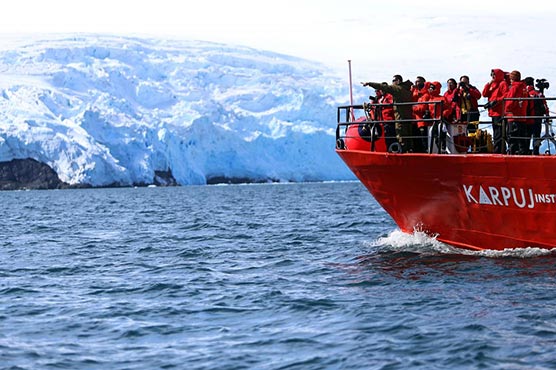Antarctic ice shelves: Searching for clues on climate change

The Chilean Antarctic Institute (INACH), Karpuj, is seen near Collins Glacier at King George island.
(Reuters) – In a remote island outpost on the edge of the Antarctic, hundreds of miles from the southern tip of Chile, scientists at a research base are scouring the ice for clues about everything from climate change to cures for cancer.
Chile’s Escudero base on King George Island acts as a research hub for a frozen expanse that extends to the South Pole, with more than 300 international scientists taking turns to brave the bitter Antarctic temperatures.
The Chilean Antarctic Institute (INACH) has supported research into a biomolecule called “Antartina,” derived from a plant native to the region, which has shown positive early results in diminishing colorectal, liver and gastric cancers in mice.
Scientists there also look at lichens that could treat Alzheimer’s disease, enzymes to remove lactose from milk and others to improve lettuce crops.
This month a multinational team embarked on a research trip to investigate what causes the break-up of ice shelves, a phenomenon associated with climate change.
In 2017, an iceberg the size of Trinidad and Tobago broke off a shelf in Antarctica, sparking widespread alarm, fears of shipping accidents and a further rise in sea levels.
“There are different theories related to changes in sea temperatures eating the platforms, and another that has to do with the behavior of water and its drainage,” New Zealand glaciologist Shelley MacDonell, the team leader, as she prepared to travel to one of the icebergs affected.
MacDonell’s team wants to be able to predict where and when ice shelves might rupture in future.
The scientists hope their research will help the mapping of the shape of world’s southernmost continent in the decades to come, and allow island and coastal nations to plan for rising sea levels.
“There is a whole dynamic (of the Antarctic ecosystem) that needs to be studied quickly, like the upcoming scenarios of climate change,” said INACH’s director, Marcelo Leppe.
Ice shelves act as a retaining wall that prevents Antarctic ice from spilling more quickly into the ocean. Icebergs have historically broken off over centuries but their break-up has accelerated in recent years.


